25 Things To Explore At The Ancient City Of Pergamon
Welcome to Pergamon, a UNESCO world heritage site that is a gem of ancient Turkey that seamlessly blends rich cultural heritage with intriguing political history. In this guide, we delve into the wonders of this once-flourishing city, including the magnificent Pergamon Theatre.
Once a vibrant center of culture and politics, Pergamon’s legacy is etched in its ruins, offering a window into a past marked by both grandeur and decline.
From invasions to natural calamities, this city has weathered it all. Join us as we explore Pergamon’s historical sites, unearthing stories and insights from an era long gone but not forgotten.
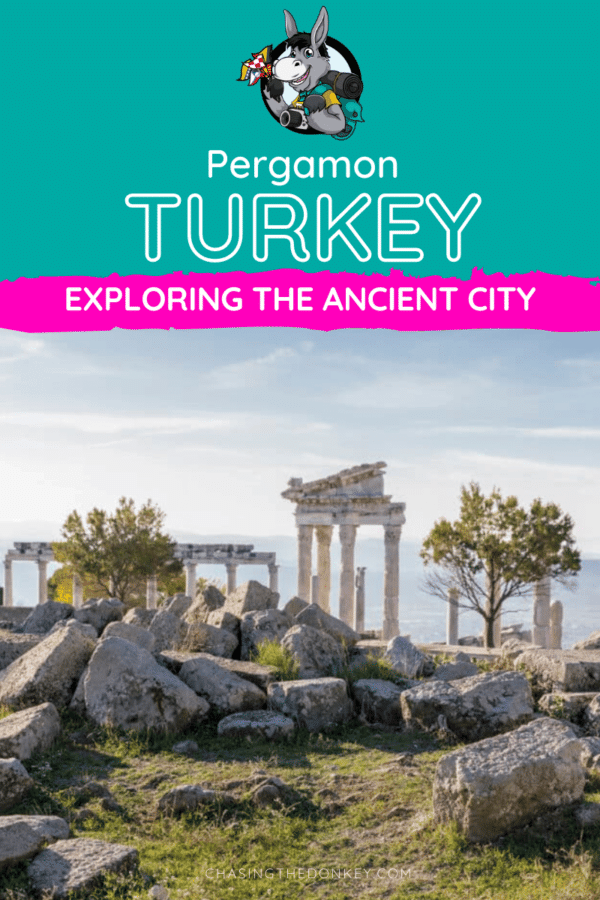
This historical gem boasts a wealth of sights that will transport you back in time to when empires rose and fell. From its towering Acropolis to the Temple of Trajan, this city has it all.
Whether you’re a history buff or simply looking for an adventure, Pergamon is sure to leave you breathless with awe-inspiring architecture and fascinating ruins waiting to be explored.
So join us as we take a journey through Pergamon’s top sights – trust us, there’s plenty not to miss!
Skip Ahead To My Advice Here!
Map Of Pergamum
Top Sights At The City Of Pergamon
When visiting the archaeological site of Pergamon, a chair lift will take you to the top (yay!). Upon reaching the summit, you will find stalls offering a selection of Turkish-style clothing, scarves, metallic souvenirs, postcards, and such.
Here are some of the top sights not to miss:
Acropolis Of Pergamon
The Acropolis of Pergamon, located on top of a hill, is the main attraction. It offers panoramic views of the surrounding area and is home to several remarkable structures and monuments.
Pergamon Theater
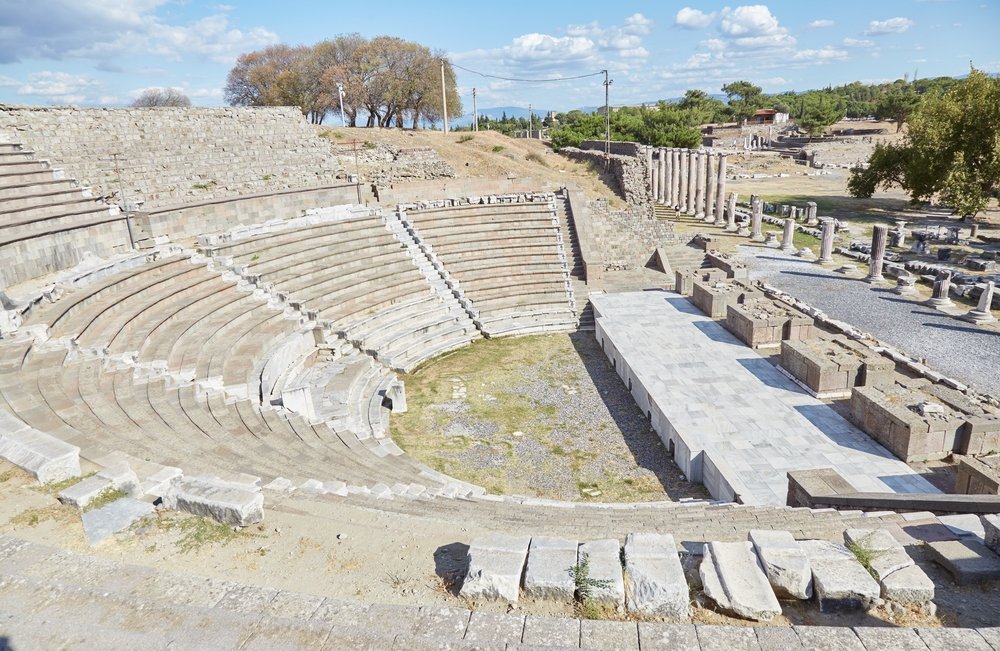
The Great Theater of Pergamon is a well-preserved ancient theater that could accommodate up to 10,000 spectators. It is renowned for its impressive architectural design and excellent acoustics.
Pergamon Altar
The Pergamon Altar is a monumental structure initially dedicated to Zeus and Athena. Although the original altar is now housed in the Pergamon Museum in Berlin, an on-site replica provides an understanding of its grandeur and intricate sculptures.
Temple of Trajan
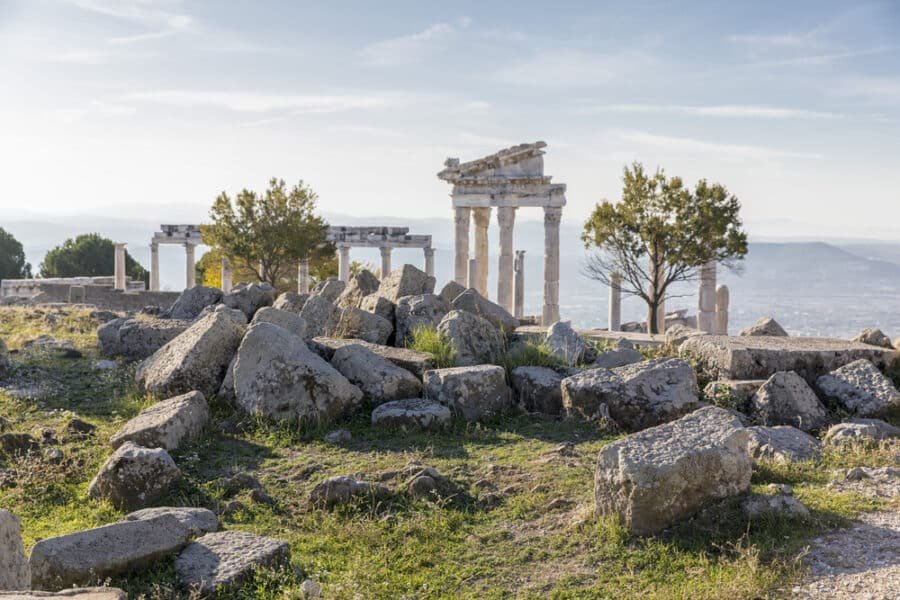
This Roman temple was built in honor of the Roman Emperor Trajan. Its ruins showcase the architectural style and influence of the Roman period.
Pergamon Library
Although the ancient library of Pergamon no longer exists, the remains of the building and its impressive facade can still be seen. It serves as a reminder of the city’s intellectual and cultural importance.
Asclepion
Located outside the main archaeological site, the Asclepion was a healing center dedicated to the god Asclepius. It consists of various structures, including a theater, thermal baths, and treatment rooms.
Pergamon Museum
In the nearby modern town of Bergama, the Pergamon Museum houses a collection of artifacts excavated from the ancient city, including the great Altar of Pergamon frieze. It is worth visiting to gain a deeper understanding of Pergamon’s history and see the original artifacts.
Exploring these sights will offer a glimpse into the grandeur and cultural significance of Pergamon in its prime.
Cafe & Toilets At Pergamon
Once you have seen all the sights, you can relax in the cafe and use the well-maintained restrooms before you leave.
Brands We Use And Trust
How Long Should You Spend In Pergamon Ancient City
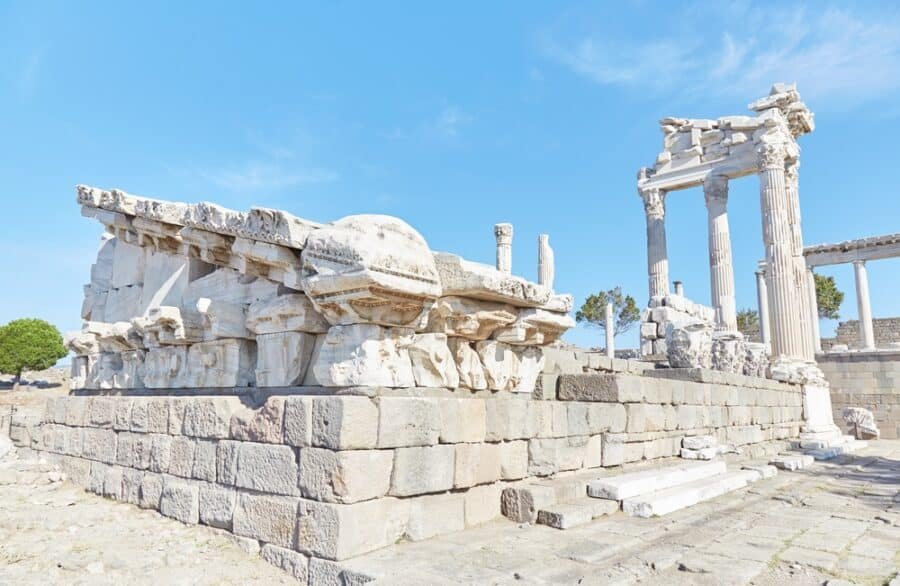
The amount of time you should spend in Pergamon depends on your interests and the depth of exploration you prefer. Generally, a full day’s visit is recommended to fully appreciate the archaeological site and its main attractions. This allows you to explore the Acropolis, visit the theater, admire the Altar of Pergamon replica, and explore other notable structures like the Temple of Trajan.
If you have a keen interest in history and archaeology, or if you want to explore the site at a leisurely pace, you might consider extending your visit to two days. This additional time allows for a more in-depth exploration of the site, including visits to the Asclepion and the Pergamon Museum in the nearby modern city of Bergama.
Keep in mind that Pergamon is a vast site with a lot to see, so it’s important to allocate enough time to appreciate its historical and architectural significance fully. Also, be prepared for walking and wear comfortable shoes as you explore the site, as it involves some uphill and uneven terrain.
- Arsenals
- Circular treatment center (also known as the Temple of Telesphorus)
- Gymnasiums
- Healing spring
- Heroön Shrine
- House of Attalus
- Library
- Lower Agora
- North Stoa
- South Stoa
- Red Basilica
- Roman baths complex
- Roman theatre
- Royal palaces
- Sacred Way (Via Tecta)
- Sanctuary of Hera Basileia
- Sanctuary of Demeter
- Sanctuary of Asclepius
- Temple of Asclepius
- Temple of Serapis
- Temple of Dionysus
- Temple of Athena
- Underground passageway
- Upper Agora
- Gate of Eumenes
Information About The Ancient City Of Pergamon
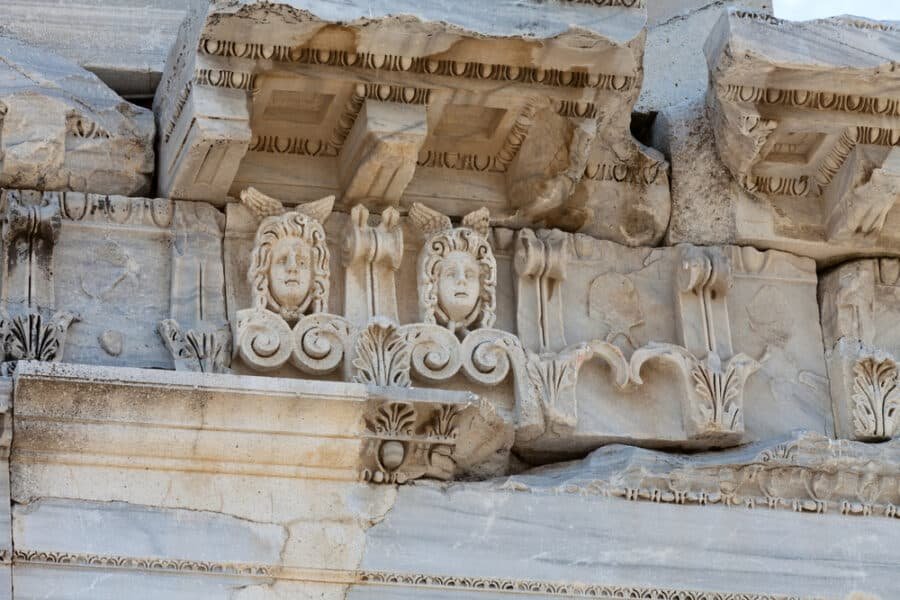
Pergamon, also known as Pergamum, was one of the most powerful ancient cities located in present-day Turkey, once part of the ancient region of Asia Minor. It holds significant historical and archaeological importance. Here is an introduction to the Ancient Pergamon, a significant site of excavation and historical study.
Pergamon was situated in the region known as Mysia, in western Anatolia (modern-day Western Turkey). It was strategically located on a prominent hill overlooking the Caicus River, offering a commanding view of the surrounding landscape.
This ancient Greek city was founded in the 3rd century BC by the Greek king Attalus I. After the ancient Greeks, it became the capital of the Attalid Kingdom, and later, the Roman Empire and the Ottoman Empire ruled Pergamon. Alexander the Great had significant influence in this region before the establishment of the Kingdom of Pergamon by Attalus III’s predecessor. Pergamon thrived as the town center of culture, learning, and political power.
Pergamon was renowned for its cultural achievements and intellectual pursuits. The city boasted a famous library, second only to the Library of Alexandria, which housed numerous manuscripts and attracted scholars and philosophers, becoming a beacon of knowledge in Ancient Greece. Parchment, known as “pergamon” or “pergamene,” was invented here.
Pergamon was adorned with impressive monuments and structures. Some of the notable architectural wonders include the Pergamon Altar, a massive Hellenistic structure featuring intricate sculptures; the Great Theatre, one of the steepest and most well-preserved theaters of the ancient world; and the Temple of Trajan, dedicated to the ancient Roman Emperor Trajan.
Pergamon was also known for its advanced medical facilities. The Asclepion, a sanctuary dedicated to the god of healing, Asclepius, served as a medical complex offering treatments and therapies.
It attracted patients seeking medical care from various regions. Pergamon faced decline and eventual abandonment in the 7th century due to multiple factors, including invasions and earthquakes. However, its ruins and artifacts have been extensively excavated and studied by archaeologists, including Carl Humann, providing valuable insights into the city’s history, architecture, and culture.
Today, the archaeological site of Pergamon is a popular tourist destination, and since 2014, it has been on the Turkish UNESCO World Heritage List. Visitors can explore the remains of the city, including its temples, theaters, and ancient streets, and marvel at the rich heritage and grandeur of this once-thriving ancient city.
Ancient Pergamon FAQs
What was Pergamon in ancient times?
Pergamon was a significant cultural and political center in the Hellenistic period, known for its rich history, including being the capital of the Attalid dynasty.
Where is Pergamum located today?
Pergamum is located in what is now modern-day Bergama, Turkey.
Where is the Pergamon Altar Today?
The Pergamon Altar is today housed in the Pergamon Museum in Berlin, Germany.
Where is the Pergamon Museum?
The Pergamon Museum is located on Museum Island in the historic center of Berlin, Germany.
What are the must-see sites in Pergamon?
Key attractions include the Pergamon Acropolis, the Great Altar of Zeus, the Temple of Trajan, and the Pergamon Theatre, one of the steepest ancient theaters.
How do I get to Pergamon?
Pergamon is accessible by road from nearby cities in Turkey. The nearest major city is Izmir, from where you can take a bus or drive to Bergama, the modern town near Pergamon.
Is a guide necessary for visiting Pergamon?
While not mandatory, a guide can enrich your experience with historical context and hidden details about the site.
Are there facilities for tourists at Pergamon?
Yes, there are facilities including souvenir stalls, a cafe, and clean restrooms at the site.
How much time should I allocate for a Pergamon visit?
A full day is recommended to explore the main sites, but an extended stay can provide a more in-depth experience, including visits to lesser-known areas.
Is Pergamon accessible for travelers with mobility issues?
The terrain can be challenging due to its steep and uneven nature. Some areas have wooden walkways, but overall, it might be difficult for those with mobility issues.
Can I buy souvenirs at Pergamon?
Yes, there are stalls selling a variety of souvenirs, including Turkish-style clothing and traditional crafts.
What is the best time to visit Pergamon?
Spring (April to June) and fall (September to November) offer pleasant weather, avoiding the summer heat and tourist crowds.
Where To Stay In Pergamon Or Nearby
When visiting Pergamon or nearby Bergama, you have a few options for accommodation. If you plan to visit the archaeological site multiple times or want to have an early start, staying in or near Bergama would be more suitable. However, if you wish to have a beachside retreat or a city experience, exploring options in Ayvalik, Dikili, or Izmir might be more appropriate. Here are some suggestions for places to stay in Pergamon or in close proximity:
Bergama
The town of Bergama is located near the archaeological site of Pergamon and offers various accommodation options, including hotels and guesthouses. Staying in Bergama allows for easy access to the site and provides additional amenities and services.
Thermal Hotels
There are a few thermal hotels located in the vicinity of Bergama that offer wellness and relaxation facilities. These hotels provide hot springs and thermal baths, allowing you to unwind after exploring the ancient ruins.
Ayvalik
Ayvalik is a coastal town located approximately 80 kilometers west of Bergama. It offers a range of hotels and resorts along its beautiful beaches. While it is a bit farther from Pergamon, it provides a seaside retreat and an opportunity to explore the Aegean Region, known for its connection to Ancient Greece and the Kingdom of Pergamon.
Dikili
Dikili is another coastal town located about 60 kilometers northwest of Bergama. It features hotels and resorts with beach access, making it a relaxing base for your visit to Pergamon.
Izmir
If you prefer a larger city experience, Izmir is approximately 100 kilometers southwest of Bergama. It offers a wide range of accommodation options, including luxury hotels, budget accommodations, and boutique hotels. Staying in Izmir allows you to explore the city’s vibrant culture and enjoy its amenities while still having the option to visit Pergamon on a day trip.
Move This Adventure To Your Inbox & Get An Instant Freebie

No spam. Unsubscribe at any time.
Pergamon Wrap Up
Pergamon, once the capital of the Attalid dynasty and a crucial city of the Roman Province of Asia, offers a deep dive into Turkey’s layered history. From its steepest theater echoing tales of the Hellenistic era to the iconic Altar of Zeus, each stone whispers stories from the Hellenistic period to Roman rule. Overlooking the Bakırçay Plain, Pergamon stands as a testament to the evolution of Greek culture, Roman emperors, and even Byzantine and Ottoman periods. I hope that my guide made your travel to this part of Turkey memorable.

